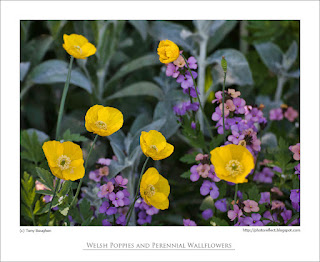.jpg) click photo to enlarge
click photo to enlargeThat we find a crystal or a poppy beautiful means that we are less alone, that we are more deeply inserted into existence than the course of a single life would lead us to believe.
John Berger (1926- ), English art critic, novelist, painter, poet
A saying in our family can sometimes be heard when we pass a house that is surrounded by nothing but lawns, with perhaps just the odd conifer to break the monotony. "All grass and no flowers" we say, re-working the title of Mike Harding's humorous, satirical play of 1980, "Fur Coat and No Knickers". We are not alone, I think, in seeing a flowerless garden as a missed opportunity, an aberration that makes one think about the state of mind of the owner. Does the person who lives there actively dislike flowers, I sometimes wonder, or do they think that grass gives them the least amount of gardening work? If it's the latter then they are wrong because there are plenty of shrubbery plantings that can be devised requiring less maintenance than the equivalent area of grass. If it's the former, then perhaps all that is implied in John Berger's thought, quoted above, comes into play. For it's surely the case that flowers are one of the finest natural beauties of the world. En masse or individually, cultivated or wild, they charm our eye, lift our spirits and inspire us. Painters have long known this, and some photographers too.

I came across Berger's words in a gardening book I was reading recently, and I thought of it again as I watched our poppies taking turns to come into flower. The assortment that we now have, a mix that has arisen accidentally rather than by design, ensures that bold points of colour are a key feature of June in our garden. From the big and blousy red and mauve oriental poppies to the delicate, yellow Welsh poppies or the bold orange and yellow California variety, poppies are a flower that make their presence felt. Subtlety and reserve are not the qualities that we associate with them. Even when the individual blooms last for only a day as do the paper-thin orange variety I posted a while ago, like a fanatical army hurled against the foe the poppies send wave after wave of replacements to take the place of the fallen.
 Our California poppies self-seed in a border at the edge of an area of trees and shrubs. The leaf canopy above makes them incline towards the light, and I caught them as they were all turned in the same direction. I photographed the big orange oriental poppy, not because it's my favourite, though many prefer it over others. Rather, it was the contrast of the rather malign looking black/purple centre next to the bright petals: a pairing I have always found attractive at a distance but slightly disconcerting when up close. We have Welsh poppies a-plenty at the moment, but this group were growing in the shade in my neighbour's garden, and I quite liked them next to the mauve of the perennial wallflowers.
Our California poppies self-seed in a border at the edge of an area of trees and shrubs. The leaf canopy above makes them incline towards the light, and I caught them as they were all turned in the same direction. I photographed the big orange oriental poppy, not because it's my favourite, though many prefer it over others. Rather, it was the contrast of the rather malign looking black/purple centre next to the bright petals: a pairing I have always found attractive at a distance but slightly disconcerting when up close. We have Welsh poppies a-plenty at the moment, but this group were growing in the shade in my neighbour's garden, and I quite liked them next to the mauve of the perennial wallflowers.
photograph and text © T. Boughen
Photo 1
Camera: Canon
Mode: Aperture Priority
Focal Length: 100mm macro
F No: f7.1
Shutter Speed: 1/100 sec
ISO: 100
Exposure Compensation: -0.33 EV
Image Stabilisation: On